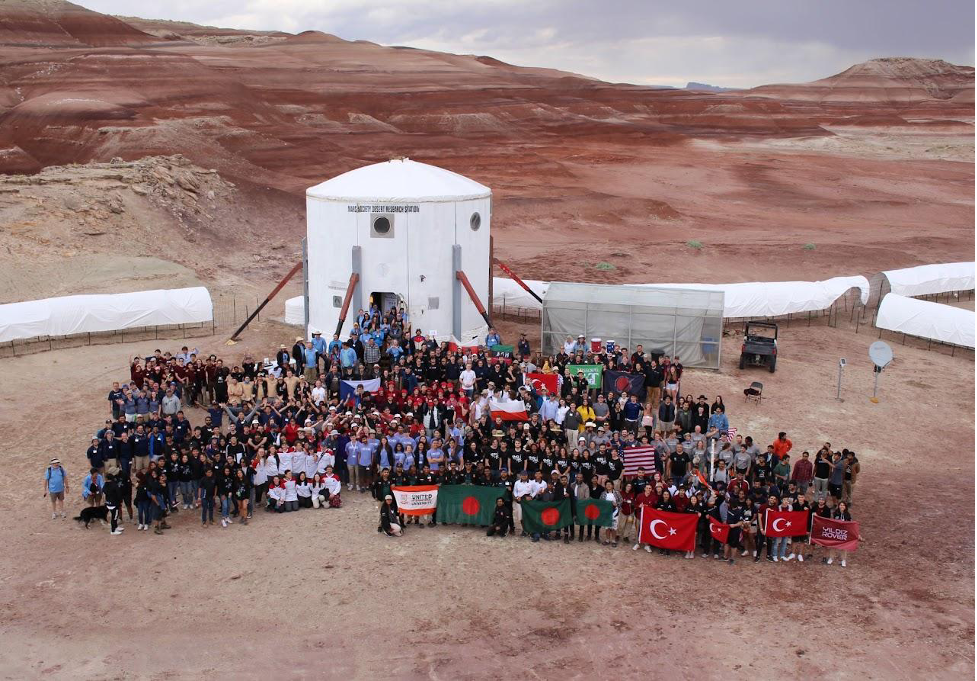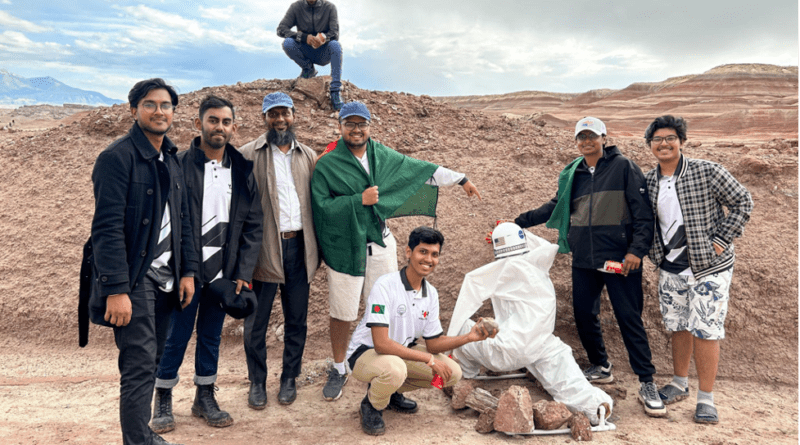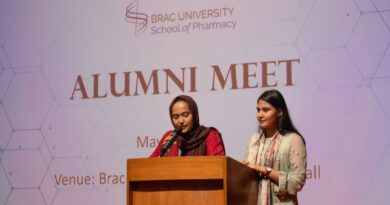From Challenges to Triumph: BRACU Mongol Tori’s Journey at the University Rover Challenge
BRACU Mongol Tori, one of the most successful rover teams of Bangladesh, has done wonders yet again- in the recent University Rover Challenge (URC) 2023. The team achieved second place among the Asian teams and sixteenth globally. This team consisted of Al Mahir Ahmed (Junior, MNS), Sanzim Rahman Khan (Sophomore, CSE), Md Shaeak Ibna Salim (Senior, CSE) and Mollah Md Saif (Senior, CSE) who participated in the URC, along with their advisor Professor Khalilur Rahman. Their present team also has the addition of Showrin Rahman (Sophomore, CSE) and Nafis Sadique Niloy (Junior, CS). On a fine midday, team lead Mahir and vice team lead Sanzim shared their adventurous experience in a recent interview with BRACU Express.
Interviewer: Thank you for taking the time to sit with us. Congratulations on behalf of BRACU Express team on achieving the second position in Asia and ranking sixteenth globally at the University Rover Challenge! Please share your initial reaction when you found out about your team’s success.
Al Mahir Ahmed: Initially, we were a bit bummed out that we achieved the sixteenth position. But then realized that we placed sixteenth worldwide and got the second position in Asia. That was when we were really thrilled about it. We’ve achieved something big in Asia, as Asia itself is a massive region, with a lot of different teams. So that was really cool!
Sanzim Rahman Khan: Apparently, this was my second competition and the result we achieved was really something. Although we may not have received the result we were intending to, we are still very proud of it, and we’re determined to do much better in future.
Interviewer: Could you describe the challenges you faced during the competition and how the team overcame them?
Mahir: We faced a lot of challenges during the entire competition. As we were a team from Bangladesh, we had a huge logistical problem with taking all the equipment with us to the USA. Then, during the competition, our rover’s circuits got shot and unfortunately, they weren’t designed to run on the different voltages used in the USA. We also faced other theoretical problems we predicted. The members overcame those by pulling all-nighters to get our rover running before the competition started. We had to work hard with all our wits and determination. And this whole uphill battle that we fought couldn’t have been done without the support of our brilliant advisor, Professor Khalilur Rahman. He was there with us, guiding and supporting us in every step towards our success.
Sanzim: We were completely in a new place when we face these challenges. We had to use different kinds of batteries to power our rover in the USA, and this caused the entire circuit board to get shot with literal fireworks. On top of that, we didn’t have any spare parts to rebuild the circuit. We could not afford losing the time it would take to purchase the components either. So, we had to work without any breaks, helping each other in any way possible to rebuild the circuits to get the rover ready for the competition the next day.
Interviewer: Were there any specific goals or targets that you set for yourselves before the competition?
Mahir: Our target for the URC was to achieve the top 10. Although, we didn’t gain that place, this year’s competition was special for us as we came back to participate in the URC after two years. And after our competition in the International Rover Challenge, we wanted to redeem ourselves in this one- this was one of the major motivators for us.

Interviewer: Could you walk us through the process of designing and building your rover? What were some of the key features and technologies that you incorporated into your design?
Sanzim: This year’s improvements have increased the capability of our rover compared to our last participation in 2019. The team had four mission objectives to cover in this competition. We improved our navigational capabilities by introducing a better GPS system to help the rover move to a certain location accurately and also set forth a more functional science module in the rover. We even installed better motor drivers and circuitry to improve the autonomous functions of it.
Interviewer: Can you inform us about the science module a little bit more?
Sanzim: Within the science mission, we had to collect three different types of soil samples and test them inside a wet lab. We incorporated this whole system within our module, and using their sensors inside, collected the data gathered from the sample and sent them to the base station. This is one of the key missions to Mars to find out if there was any life that existed before. For the first time, we have included this functional science module to complete this mission.
Interviewer: Collaboration and teamwork are crucial in such challenging competitions. How did your team ensure that?
Mahir: Teamwork is the key! We continuously supported each other although we had specific responsibilities; be it issues with navigational parts or wiring of the rover, the entire team would look into it together. Without this supportive environment, we couldn’t have completed all the missions in this competition.
Interviewer: What sets your team apart from other participants in terms of innovation, strategy, or unique approaches to problem-solving?
Mahir: In my opinion, the most unique feature that we had as a team was resourcefulness. We worked relentlessly to overcome the problems we faced. During the award ceremony, we had the chance to talk to the other teams as well and learned how some have faced similar issues like ours. However, we were efficient enough to come with a solution and completed everything as a team with sheer determination.
Sanzim: I’d like to add on to how the team created a very advanced mechanical design for this rover. This has made our rover travel through rough and tricky terrain where most of the competing teams were unsuccessful.
Interviewer: The field of robotics and space exploration is constantly evolving. How did your team incorporate innovative technologies to stay ahead of the curve?
Mahir: In the case of navigation, we introduced depth cameras to our design. This helped us determine the distance between the object and rover, which helps the rover travel to any certain point very accurately.
Sanzim: Apart from that, we also improved a lot in AI and sensory technology. Our AI algorithms have improved a lot in identifying soil samples, stone detection, and tool detection precisely.
Interviewer: During the competition, did your team have any interesting interactions or knowledge-sharing experiences with other participating teams?
Mahir: After days of working with machines, everyone was pretty exhausted. So we ended up having just usual conversations, which itself was interesting as we got to know about different people coming from different parts of the world.

Interviewer: Participating in such competitions demands a significant investment of time and effort. How did your team manage balancing between academic commitments and competitions?
Mahir: It is honestly really hard to manage both. Personally, I have to give more time for rover, compared to what I invest in academics. Sometimes it affects my academic results, but I tend to study as much as I can.
Sanzim: I had to drop a semester to give my full attention to this challenge. It is hard, but the thrill and experience make everything worth it. I try my best to keep a balance between both. I have always seen our seniors manage somehow, so that keeps me going too.
Interviewer: The URC is an excellent platform for networking and building connections within the robotics and space exploration communities. Have any opportunities or collaborations emerged for your team?
Mahir: One of the judges of this competition, Helen, exchanged a lot of ideas with us. She is a working scientist at NASA and we’re planning to have regular discussions with her on how to improve the science missions.
Sanzim: As the majority of us are from CSE or MNS departments, we do have some knowledge gaps about the scientific sides of the rover missions and Mars itself. Having the opportunity to converse with the leading scientists from similar field was a great opportunity for us.
Interviewer: Please share with us what this achievement means to your team and your university?
Mahir: After our return, we saw our juniors being very motivated by our performance. I believe our achievement has been an inspiration for many aspiring students here at BracU. The other rover teams- Duburi and Dishari, were also inspired to do even better than us; and we hope that they do. So yeah, it shows how competitive and determined the students in this institution are.
Interviewer: Beyond the competition, what are your personal ambitions in these fields?
Sanzim: I am personally in charge of the mechanical side of Mongol Tori. I want to make it much better and more efficient before my tenure is over. Hopefully, someday this will contribute to our mission to Mars as an entire species.
Mahir: I don’t have specific goals per se, but I love creating things. So I still want to contribute in building a better rover that can be a pinnacle of technology within our hands.
Interviewer: Finally, what advice would you give to the aspiring teams who are considering participating in the URC or similar competitions?
Mahir: Firstly, you have to be prepared. Expect the worst. Because in a competition like this, anything can happen. So you’ve got to be committed to go through whatever challenge you’ll face. Sanzim: I would advise to stay really focused on fixing the problem you’ll face. Keeping a checklist of the essentials that you need to have for the competition is a must. And lastly, having the mentality of winning is the key to success in these sorts of competitions. That’s all!




